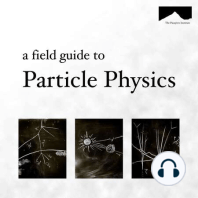3 min listen
The Higgs Boson
ratings:
Length:
4 minutes
Released:
Oct 8, 2021
Format:
Podcast episode
Description
The Field Guide to Particle Physics https://pasayten.org/the-field-guide-to-particle-physics©2021 The Pasayten Institute cc by-sa-4.0The definitive resource for all data in particle physics is the Particle Data Group: https://pdg.lbl.gov.The Pasayten Institute is on a mission to build and share physics knowledge, without barriers! Get in touch.The Higgs BosonAs far as we know, there is no other particle like the Higgs Boson, but there probably should be.The Higgs is a difficult particle to describe because it almost always manifests in ways that don’t resemble particle behavior. The relationship between the photon and magnetic fields comes to mind. We sometimes call the Higgs’ amorphous presence the Higgs “field”.Just as magnetic fields can permeate space, so too does the field of the Higgs. Unlike a magnetic field, which usually requires some physical source - like a collection of iron atoms in a refrigerator magnet or a spinning particle like the neutron - the Higgs field is naturally always set to “on”.Every once in a while, a disturbance in that field appears as a particle, the Higgs Boson.When the Higgs does present as a particle, it’s fairly heavy. With a mass of 125 GeV, it’s one of the heaviest elementary particles around. Like many other heavy particles, the Higgs is unstable. It decays quickly, most often to a quark/antiquark pair, but has a lot of other options. It’s mean lifetime is somewhere near 0.0000000000000000000001 = 10^−22 seconds. That is much longer than the W or Z bosons, but still far too fast for a human to have an intuition for.The Higgs does not have an electric charge. Or any charge, practically speaking. Although it does interact with the electromagnetic and weak forces. It’s interactions with matter are more intricate.The field of the Higgs interacts with the quarks and the leptons, like the electron and its neutrino. Less like a field and more of a swamp, the Higgs field slows those particles down quite a bit. The added resistance to motion through the Higgs field is something we’ve come to call mass.In this way, the Higgs field give a tiny mass to many of the elementary particles. A related - but different - effect gives the mass to the W and Z bosons as well.But do not be fooled! The mass endowed by the Higgs mechanism has almost nothing to do with the mass we experience in daily life. Virtually all of that mass comes from interplay of quarks, gluons and the subnuclear goo that surrounds quarks inside of protons and neutrons.The Higgs Boson - the particle excitation of this field - can be found whenever the particles it gives mass to are colliding at high speeds. It’s part of the shrapnel, if you like. The Higgs field and its associated boson is surely the odd duck of the subnuclear zoo. There are many questions physicists are still pondering about its nature, such as its mass and outsized role in the universe. One important question seems to be: why is there only one such field? Are there other fields out there, also switched “on” and having some impact on our history, or even our day to day lives? Models that describe the Big Bang and the very earliest moments of our universe - now a precision science - suggest that there should be.
Released:
Oct 8, 2021
Format:
Podcast episode
Titles in the series (49)
The Tau: The tau is a very heavy species of elementary particle that aren’t quite as common as the electron or the muon. Nevertheless, just as the muon shares many of the properties with the electron, so too does the tau. by The Field Guide to Particle Physics
